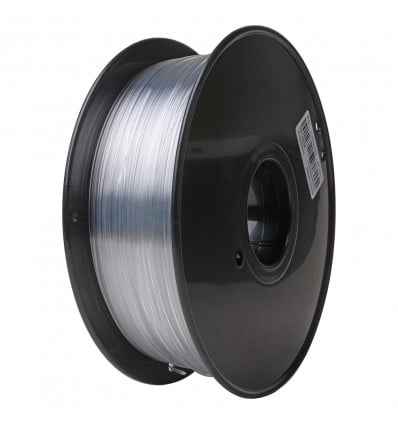International shipping Secure payment
No products
Prices are tax included
Product successfully added to your shopping cart
There are 0 items in your cart. There is 1 item in your cart.
This 1kg roll of SunLu Transparent Polycarbonate Filament is designed for durable functional prints, offering strong impact resistance and heat resistance.
5+ In Stock Items
Warning: Last items in stock!
Free shipping on orders over R1250 - courier delivery and within South Africa
Polycarbonate filament offers a highly durable solution for printing the functional parts of your dream projects. Some PC polymers even outshine acrylic materials like PMMA and achieve less than half the density of most glass structures as well. This makes PC not only durable, but also lightweight compared to many of the alternatives on the market. And just to top off the already-impressive characteristics, Sunlu Polycarbonate Filament is designed for high impact strength and heat resistance!
As an exotic filament, SunLu Polycarbonate has much to offer Makers who need mechanical strength and more resistance or durability than PETG and ABS. It’s not surprising that polycarbonate is relatively difficult to print with, but the reward is worth the effort. Read our polycarbonate printing tips at the bottom of this description and once your 3D printer settings are dialled in, you’re ready to go. SunLu Polycarbonate is capable of producing incredible prints with high strength, great resistances to external forces, and very high thermal resistance. The transparent colour of this SunLu Polycarbonate also leads to fun possibilities. Print your own lighting, electronic covers, automotive parts, and water bottles.
SunLu Polycarbonate Filament – Technical Specifications: |
|
|
– SunLu |
|
– PC (Polycarbonate) |
|
– Transparent |
|
– 1.75mm |
|
– 52 |
|
– 2400 |
|
– 15 |
|
– 65 |
|
– 2300 |
|
– 55 |
|
– 102°C |
|
– 1kg |
SunLu Polycarbonate Filament – Suggested Print Settings: |
|
|
– 250 to 270 |
|
– Brass / Any |
|
– 0.4mm |
|
– 90 to 110 |
|
– PEI | Polycarbonate |
|
– 40 to 60 |
|
– 5mm |
|
– 50 |
|
– 50 |
|
– On from Layer 2+ |
|
– Fully Enclosed |
|
– Ambient Printing Temperatures |
Helpful 3D Printing Tips for SunLu Polycarbonate Filament:
As many of you will know, here at DIYElectronics, we always try to give our fullest support for every item we sell, and this includes all of the different types of 3D filaments too. With this in mind, the following are some really useful tips that we wished we knew when we started printing with polycarbonate, which we hope you can utilise to enjoy the great results that we’ve been working toward since first testing out this high-strength polymer:
- Polycarbonate Printing Tips – Extrusion: As an extra tip for success, we’ve found that printing with a 5:1 Line Width to Nozzle Size ratio yields excellent results with near-invisible layer lines. However, this isn’t quite as easy as it sounds, as it is in regard to the area, rather than direct size comparison, because numbers involving area need to be squared. As such, if you’re eager to print with a standard size 0.4mm nozzle, then you will want your extrusion line width to be 0.9mm, because 0.9mm squared is 0.81mm, and 0.4mm squared is 0.16mm – and of course 0.81 divided by 5 is just over 0.16. So be sure to keep this in mind if you’re printing with Polycarbonate, as these settings will not only produce beautiful aesthetics on the finished print, but will also help ensure that the layers are fused well to each other, adding value to structural integrity too.
- Polycarbonate Printing Tips – Adhesion: Additionally, although we at DIYElectronics love BuildTak, and will generally recommend it for most 3D printing filaments and polymers, polycarbonate is a little bit different, and tends to fuse with BuildTak at temperatures around 80°C and higher. And because you need a heated build surface of around 100°C to print polycarbonate effectively, the fusing is almost unavoidable without some extra preparation such as an additional adhesive layer. As such, we will always recommend PEI instead, which holds well to polycarbonate at temperatures between 100° and 110°C, before self-releasing the prints upon cooling down. This not only helps make 3D printing this material easier, but also ensures no fused beds and optimal surface finishes – even on the bottom of the print.
- Polycarbonate Printing Tips – Layers: Polycarbonate filament, like ABS and a few other high-temperature polymers, tends to warp very easily if the condition isn’t just right. This means that you need to print your first layer nearly perfectly, so that the following layers have all the adhesion they need to stick, fuse and mould together in the ways they need to for strong parts. As such, it’s a good idea for your first layer to set the layer height to somewhere between 100% and 150%, with a first layer width of between 120% and 150%, as well as a first layer speed of between 15% and 30%. This will help to produce an excellent first layer, after which the following layers can simply be printed normally without any extra fuss. Additionally, when building bridges between various parts of the print, it’s important to go slow, allowing the polycarbonate to harden as the cooling fan lightly blows on it. This will ensure strong bridges with little to no droop or sag, and overall beautiful results that are both aesthetically striking and strong.
- Polycarbonate Printing Tips – Fan Speed: Finally, the fan speed is the last important factor to consider for 3D printing polycarbonate, and is arguably the trickiest since many fans on hobbyist 3D printers don’t offer real speed control. Typically, you want the fan to be off the first one or two layers, to allow the first layer to really sink in and settle, after which you want to turn the fan speed up to around 40% or so, and this should provide just enough cooling to harden the layers, but without being overbearing and causing cracking or brittleness in the finished print. However, as we mention, many fans can’t be controlled to such a degree, so consider just experimenting with whatever settings or hardware you have to try and accommodate for this if you can’t directly adjust the fan speed.
Here at DIYElectronics, we’ve had many years of experience in printing with polycarbonate, and we hope that these top tips that we’ve gathered over the years does well in helping you get the best results and most enjoyment out of your polycarbonate printing experience. Just remember that it is likely going to take some time to “dial in” your 3D Printer for this exotic filament, so it’s always a good idea to find as many resources and videos as you can before taking on this challenging but very rewarding polymer.
| Colour | Clear |
| Special | Transparent |
| Plastic Type | PC (Polycarbonate) |
| Plastic Diameter | 1.75mm |
| Plastic Weight | 1kg |
No customer reviews for the moment.
Although it may not be a popular brand here in SA (yet!), many 3D Makers will recognise the name SunLu, as these fantastic 3D Filament Makers have been involved in 3D Printing since as far back as 2013, specialising in affordability & accessibility, but placing a strong focus on R&D & bringing new materials to the market for 3D Makers to enjoy.
From the classic PLA & ABS range through to the more exotic styles like PETG & TPU, as well as what we like to call Semi-Exotics like Marble & Twinkling Filament, SunLu has garnered a lot of experience in the world of 3D Filaments, & have one of the most comprehensive catalogues that the Hobbyist 3D Printing world has ever seen. This gives them a good spot amongst the leaders in 3D Filaments, & while they may not quite match the premium quality of Fillamentum & other high class brands, the affordability & range of options that SunLu offers is simply unbeatable even for the major players.
If you’re looking for a good brand to use for all kinds of different prints & applications, but don’t want to pay a premium, SunLu is the ideal brand that is ready to become your next new favourite. So get out there & start testing out the range that SunLu has to offer! With so many options available & a price that is low enough to simply take a chance with, there’s absolutely no reason why you shouldn’t give SunLu a chance & test this awesome brand out, to see if it’s a good fit for your 3D Printing fun.







